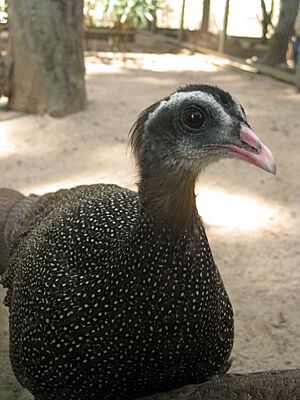Vietnamese crested argus facts for kids
The Vietnamese crested argus (Rheinardia ocellata) is a large and amazing bird that looks a lot like a peafowl. It has dark brown spots on black and light brown feathers. It has a big pink beak, brown eyes, and blue skin around its eyes. This bird has two crests (feathery tufts) on its head. The one at the back of its head stands up when the bird is scared or when it's trying to find a mate.
Male Vietnamese crested argus birds have a very long and wide tail with twelve feathers. Their tail feathers are the longest and widest of any wild bird! These feathers can be up to 1.73 m (5.7 ft) long. This makes the whole bird about 1.9–2.39 m (6.2–7.8 ft) long.
Quick facts for kids Vietnamese crested argus |
|
|---|---|
 |
|
| Female | |
| Conservation status | |
| Scientific classification | |
| Genus: |
Rheinardia
|
| Species: |
ocellata
|
Contents
What Does the Vietnamese Crested Argus Look Like?
The female bird is about the same size as the male. She has beautiful marbled patterns and more colorful feathers on her back. Her face has noticeable white feathers with a special pattern that helps her blend in. The female's crest is different from the male's. It has stiffer feathers that cover more of the back of her head and neck. Her tail is also long and flat, like the male's, but much shorter. Females are usually about 74–75 cm (2.43–2.46 ft) long.
Even though males are longer than females, they only weigh about 20% more. Both male and female birds weigh around 1.5 kg (3.3 lb).
Wings and Legs
The wings of the Vietnamese crested argus are quite special for their size and weight. They are wide and square, which is different from the rounded wings of most pheasants. This shape suggests that these birds can fly for a long time without stopping. Their wings are similar to those of some birds that live partly in trees, like guans.
The legs and feet of the crested argus are also interesting. Males have unique leg scales that are very wide, making their legs look a bit like a lizard's front legs. Their toes are long and thin. Like other peafowl, their back toe is not as flat as those of birds that spend all their time on the ground.
Life and Habits
We don't know much about these birds in the wild because they are very shy and hard to find. The Vietnamese crested argus lives in mountain forests in Vietnam and Laos in Southeast Asia.
What Do They Eat?
Their diet mainly includes small creatures without backbones, like insects and snails. They also eat amphibians (like frogs), small reptiles, bamboo shoots, leaves, fruits, and mushrooms.
Reproduction and Family Life
Scientists are still learning about how these birds have babies. Some people think the male birds might mate with many females, but there's no clear proof of this yet.
Male birds perform special dances and movements to attract a mate or scare away predators. They might push their wings and tail into the ground, leaving marks in the sand or leaves. They can also flatten their body and spread out their long tail feathers. During these displays, the male keeps his head low to the ground. He also puffs up his neck feathers and makes a hissing sound while stomping his feet. Like other peafowl, they use these displays to protect themselves from predators, especially reptiles.
Where Do They Live?
Local people who live near these birds say that both male and female birds choose high places to build their nests, often on steep slopes among fallen leaves. They lay only one or two large eggs, which hatch after about 25 days. Like other peafowl, baby crested argus chicks are born with well-developed wing feathers. For the first few weeks, their parents feed them by putting food directly into their beaks. In zoos, male birds also help raise the chicks, feeding them and keeping them warm both on the ground and in trees.
Like other peafowl, Vietnamese crested argus birds spend many hours a day resting on tall trees above the forest. They might stay in these trees for days during the rainy season. These birds are strong fliers, and pairs have been seen flying together.
Status and Protection
The Vietnamese crested argus is in great danger. Because their habitat (the place where they live) is being destroyed and because they are hunted too much in some areas, they are listed as Critically Endangered on the IUCN Red List. This means they are at a very high risk of becoming extinct in the wild. They are also protected under CITES, which controls the trade of endangered animals and plants.



